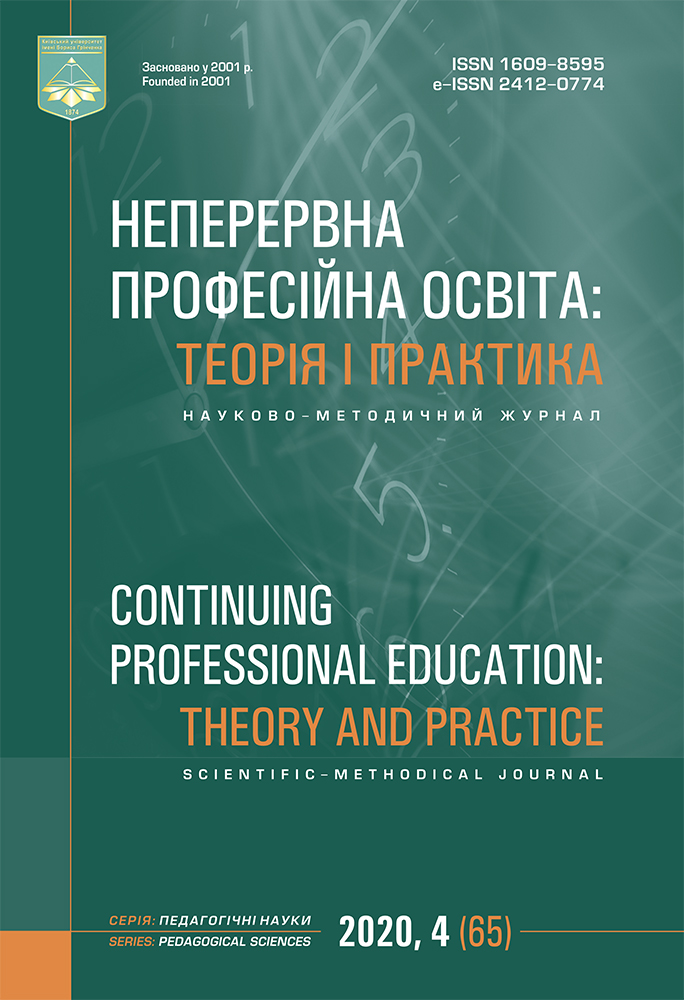USE OF VISUALIZATION TECHNOLOGIES IN DISTANCE LEARNING OF THE UKRAINIAN LANGUAGE IN INSTITUTIONS OF GENERAL SECONDARY EDUCATION
DOI:
https://doi.org/10.28925/1609-8595.2020.4.9Keywords:
distance learning, general secondary education, methods of teaching the Ukrainian language, visual literacy, pedagogical technologies of visualizationAbstract
The article highlights the features of the use of visualization technologies during distance learning of the Ukrainian language in general secondary education. Scientific works on the coverage of the outlined problem in them are analyzed. It is proved that an effective learning tool, a productive methodological tool for intellectual development of students is the visualization of educational material. The peculiarities of the preparation of educational information are determined, which in a visually accessible for perception and understanding form can provide students with basic or necessary information. It is emphasized that the principle of cognitive visualization is based on psychological laws, according to which the effectiveness of learning increases through the connection to the process of perception of the «figurative» right hemisphere. The peculiarities of using the technology of visualization of educational material, in particular in distance learning, are substantiated. Techniques of structuring and visualization of educational material are described. Emphasis is placed on compliance with certain recommendations to achieve the goals set in the implementation of visualization technologies. It is emphasized that when working on the visualization of educational material, it is necessary to take into account certain patterns of perception of visual aids by students. The typical mistakes that are most often made in the process of visualization of educational material are analyzed, recommendations are given to eliminate them. It was found that the use of distance and blended learning and the significant potential of multimedia learning tools encourage teachers to use visualization in the educational process, which contributes to the intensification of the process of learning. Examples of realization of various pedagogical technologies of visualization in the process of teaching the Ukrainian language in general secondary education institutions in a distance format are given.References
Analitychna dovidka Derzhavnoi sluzhby yakosti osvity Ukrainy shchodo orhanizatsii dystantsiinoho navchannia v zakladakh zahalnoi serednoi osvity v umovakh karantynu (za rezultatamy onlain-anketuvannia uchasnykiv osvitnoho protsesu v period z 08 po 15 kvitnia 2020 roku) [Analytical certificate of the State Quality Service of Education of Ukraine on the organization of distance learning in general secondary education in quarantine (according to the results of online surveys of participants in the educational process in the period from 08 to 15 April 2020)] (2020). https://bit.ly/3nmbtsV
Babych, O., Semenikhina, O. (2014). Do pytannia pro spivvidnoshennia poniat naochnist i vizualizatsiia [On the question of the relationship between the concepts of clarity and visualization]. Fizyko-matematychna osvita. Naukovyi zhurnal, № 2 (3), 47–53.
Belousova, L. Y., Zhyteneva, N. V. (2014). Dydaktycheskye aspektы yspolzovanyia tekhnolohyi vyzualyzatsyy v uchebnom protsesse obshcheobrazovatelnoi shkolu [Didactic aspects of using visualization technologies in the educational process of a comprehensive school]. Informatsiini tekhnolohii i zasoby navchannia, 40 (2), 1–13.
Bilousova, L. I., Zhytienova, N. V. (2017). Funktsionalnyi pidkhid do vykorystannia tekhnolohii vizualizatsii dlia intensyfikatsii navchalnoho protsesu [A functional approach to the use of visualization technologies to intensify the learning process]. Informatsiinii tekhnolohii i zasoby navchannia, 57 (1), 38–49.
Vorotnykova, I. P. (2019). Dosvid vykorystannia E-pidruchnykiv i elektronnykh zasobiv navchalnoho pryznachennia v umovakh tsyfrovizatsii zahalnoi serednoi osvity Ukrainy [Experience of using e-textbooks and electronic educational means in school within the framework of general secondary education digitalization in Ukraine]. Information Technologies and Learning Tools, 71 (3), 23–39. https://doi.org/10.33407/itlt.v71i3.2552
Dyka, N. M. (2017). Movna osobystist: mizhdystsyplinarnyi aspect [Linguistic personality: interdisciplinary aspect]. Pedahohichna osvita: teoriia i praktyka. Pedahohika. Psykholohiia, 27, 4–7.
Dyka, N. M.; Hlazova, O. P. (2018). Nova paradyhma pisliadyplomnoi pedahohichnoi osvity: realizatsiia kompetenstnisnoho pidkhodu [A new paradigm of postgraduate pedagogical education: implementation of the competency approach]. Neperervna profesiina osvita: teoriia ta praktyka, 1–2, 14–20. https://doi.org/10.28925/1609-8595.2018.3-4.1420
Ilina, H. (2018). Vizualna hramotnist u konteksti kohnityvnykh ta osvitnikh protsesiv [Visual literacy in the context of cognitive and educational processes]. Visnyk KNTEU, 1. http://visnik.knute.edu.ua/files/2018/01/15.pdf
Lavrentev, H. V., Lavrenteva, N. B., Neudakhyna, N. A. (2002). Ynnovatsyonnye obuchaiushchye tekhnolohyy v professyonalnoi podhotovke spetsyalystov [Innovative teaching technologies in professional training of specialists]. Altai State University. http://www2.asu.ru/cppkp/index.files/ucheb.files/innov/Part2/ch8/glava_8_1.html
Morze, N. V., Glazunova, O. G., Kuzminska, O. G. (2017). Pidhotovka menedzheriv E-navchannia: kompetentnisnyi pidkhid [Training of e-learning managers: competency approach]. Information Technologies and Learning Tools, 60 (4), 220–238. https://doi.org/10.33407/itlt.v60i4.1761
Nurbekova, Z., Grinshkun, V., Aimicheva, G., Nurbekov, B., Tuenbaeva, K. (2020). Project-based learning approach for teaching mobile application development using visualization technology. International Journal of Emerging Technologies in Learning, 15 (8), 130–143. https://doi.org/10.3991/ijet.v15i08.12335
Osinska, V., Osinski, G., Kwiatkowska, A. B. (2015). Visualization in Learning: Perception, Aesthetics, and Pragmatism. In A. Ursyn (Ed.), Handbook of Research on Maximizing Cognitive Learning through Knowledge Visualization (pp. 381–414). IGI Global. https://doi.org/10.4018/978-1-4666-8142-2.ch013
Downloads
Published
How to Cite
Issue
Section
License
Copyright (c) 2020 Natalia Dyka, Oleksandra Glazova

This work is licensed under a Creative Commons Attribution-NonCommercial 3.0 Unported License.



